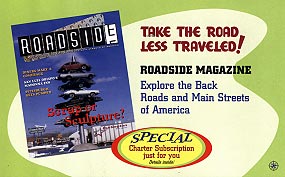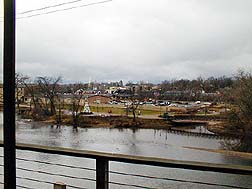|
The Rise and Fall of Roadside Magazine |
 |
||||||||||
|
Chapter 13 The clouds gathered in April. During the second round of editorial meetings, we finalized our editorial calendar outlined last March, and I found that most of my suggestions for stories met with little resistance. On the other hand, they didn’t meet with much enthusiasm either.
I had always envisioned a Roadside staff meeting with people who readily understood its mission, where mutual sensibilities melded into a creative and philosophical force. I wouldn’t have to explain anything. Discussions with Teri rarely centered on reasons for our editorial decisions. We instinctively knew what worked. In Batavia, I struggled to find the proper words to describe Roadside’s reason for existence and what made it unique to people intent on finding places to plug in their formulas. On the first day, our agenda called for drafting our mission statement. The corporate world is big on these, and companies expend a great deal of time and thought on drafting something they forget a year later. Back at the hotel over breakfast, our new publicist Bob Wiener and I discussed the matter. He asked me what I thought it should be. Not skipping a beat, I said, “Roadside’s a magazine that explores the Main Streets and back roads of America.” “You can’t use that. It’s not enough.” “Yes, but that’s what the magazine does.” At the meeting, we addressed the topic. After two hours of crafting complex verbiage, a mission statement emerged that stretched well over thirty words. Just as we thought we had finished, Mr. Ball entered the room, asking what we had wrote on the whiteboard. Informed it was the mission statement, he shook his head. “No,” he said. “Our mission statement is this: Roadside explores the back roads and Main Streets of America.” I think I just let out an audible sigh at that point. With Bob pressing us for stories with a publicity angle, I did have to consider the timing of major events in drafting the calendar. For some reason, the features had to fall into regular categories of food, travel, and preservation. Each issue had to have a story devoted to each. We needed to rename most of the departments. We had to deemphasize the “diner thing,” a prospect I actually supported as long it maintained a regular presence. A presidential election loomed, and most at the meeting believed we needed a controversial, politically-oriented story for our launch issue, scheduled for October. Also, to my dismay, my new employers seemed awfully intent on getting “name” writers and incorporating the opinions of celebrities into the content. To me, celebrity meant next to nothing, but I had no serious objections because I knew that our very obscurity would make the issue mostly moot. Yet, they asked me to track down the likes of Calvin Trillin, Saul Bellow, and Jim Harrison, Martens’s favorite author. Though this trip to Batavia featured many highlights, including the train ride out from Worcester on a sleeper and the retrieval of the new company Jetta, the meetings also heralded what for me looked like the beginning of the end. Only two months into this deal, and I saw the magazine heading into dangerous territory. A fateful moment came toward the end of the first meeting. I knew that the art department had begun work on a new template for the magazine, but no one told me this included a new logo for “Roadside.” Though trained as a designer, I had always wondered what this magazine would look like in the hands of someone else. I looked forward to a new layout for Roadside if for no other reason than the time had come for such a change. But to me, the logo was sacrosanct. It worked. People liked it. And it was an established mark seen by thousands. With all the other tasks before us, why waste the time? With everyone in the room, including Mr. Ball, Ball Publishing’s young art director presented five new logo designs for the magazine. Completely unprepared for this presentation, I sat stunned, unable to speak. Again, I glanced at Mr. Ball for some indication of disapproval, but he just studied the designs without expression. Had any of the designs actually looked better than what they threatened to replace, I would have congratulated the designer for job well done. I strained to conceal my disappointment with designs unfit for use on a family newsletter. Nudged to speak, I muttered something about the use of color, and patiently awaited the day to end. I just wanted to get to a phone and call Teri. The next morning, at the start of the next meeting, with myself, Jennifer, the company’s marketing director and Bob Wiener present, I opened up. “Okay, before we begin, could somebody please tell me who’s decision it was to change the logo?” Jennifer, keeping her cool, replied, “John decided we needed a new look for the magazine.” “Really? Well, it’s too bad then because I saw better work in my first year of design school than what I saw up there yesterday.” At that moment, Martens walked in the room. “What are we talking about?” Jennifer replied, “Randy wanted to know why we’re changing the logo.” Settling into his chair with ease, John looked at me, grinned a bit, and with a pound on the table for emphasis declared, “Oh no. I want to bury this diner thing! End of discussion.” I always said I’d keep doing Roadside as long as it was fun. When John’s hand hit the table, that fun finally ended.
During the rest of the meeting, my mind drifted down the Fox River flowing past our window. I began to wonder what these people even needed me for. My participation in the discussion tapered off as I sat and considered my options. With no answers coming immediately to mind, I puzzled over Mr. Ball’s response or lack thereof over the design direction. I spent much of the last day doing some actual work, later planning to attend the grand opening of the Burpee Gardens store in Downers Grove. Upon arriving at the packed and beautifully designed retail outlet, I chatted politely with my new coworkers and wandered around browsing the upscale selection of garden wares, clothing, gifts, internet café, and oh yes, the seeds. Eventually, I came up on Mr. Ball’s radar, who came over to me to introduce me to a Downer’s Grove town official. “And this is Randy Garbin,” he began. “He and I are partners in this new magazine called Roadside.” And with complete sincerety, Mr. Ball added, “He’s a genius!” Though I wouldn’t describe myself as perfectly modest, Mr. Ball’s enthusiasm actually embarrassed me, but if that’s what he actually thought, then I should just enjoy it while it lasted. Later in the evening, Mr. Ball got up to speak and to give the obligatory thank yous and cite the folks responsible for the store’s opening. I watched him speak with great animation, mindful of the horror show I had just endured back at the office for the past few days. I thought also of the lengthy road trip back home via Michigan’s upper peninsula and down through Pennsylvania. My mind considered the opportunity this man had given me to finally shine and to finally take Roadside into the world. I despite this ordeal, I remained grateful towards Mr. Ball. Maybe, just maybe, the struggle would settle into some kind of comfortable mode, and all would be fine. No, I won’t quit now, I thought as I watched Mr. Ball effusively praise his staff and the town and Mom and apple pie and whatever else crossed his unpredictable mind. I can’t let this man down. Next time: The Daily Headache |
|
||||||||||
|
©2001 Randy Garbin |

